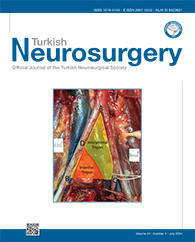2San Giovanni-Addolorata Hospital, Pain Therapy Unit Rome, Rome, Italy
3?Ospedale del Mare? Hospital, Department of Neurosurgery, Naples, Italy
4Catholic University School of Medicine, Department of Neuroscience, Section of Neurosurgery, Rome, Italy DOI : 10.5137/1019-5149.JTN.44931-23.4 AIM: To report our institutional experience with full-endoscopic lumbar discectomy (FELD) and analyzed the pertinent literature.
MATERIAL and METHODS: We retrospectively enrolled 100 patients who had undergone full-endoscopic discectomy for lumbar disc herniation using either an interlaminar (IL) or transforaminal (TF) approach. All patients underwent pre-operative imaging. Before and after surgery, patients? pain and disability levels were measured using visual analog scale (VAS) and Oswestry disability index (ODI) respectively. Clinical outcomes were assessed using the modified MacNab criteria. Patients were divided into two groups, Group 1 (cases 1-50) and Group 2 (cases 51-100), and their learning curve factors were compared using a Student?s t-test.
RESULTS: Sixtynine cases were operated via an IL approach and the remaining 31 cases using a TF approach. There were 4 early conversions in microdiscectomy. The mean operative time of the 96 procedures was 57 min. In Group 1, the mean operative time was 61.7 minutes (range: 35-110); in Group 2, it was 52.3 minutes (range: 25-75). The difference between the two groups was statistically significant (p=0.009). No significant differences were found in conversions, early operations, and recurrences between Groups 1 and 2. Both groups experienced a significant reduction in postoperative VAS and ODI compared to preoperative scores.
CONCLUSION: The findings support previously reported information on the safety and effectiveness of the FELD. Herein, we share some practical tips and tricks based on our initial experience and on the review of the available literature, which could facilitate new users. In experienced hands endoscopic techniques make treatment of herniated discs feasible independently of patient age, anatomy, and/or targeted pathology features. Conversely, thoughtful patient selection and careful preoperative planning are highly recommended for new users.
Keywords : Full-endoscopic lumbar discectomy, Learning curve, Lumbar herniated disc, Minimally invasive spine surgery




